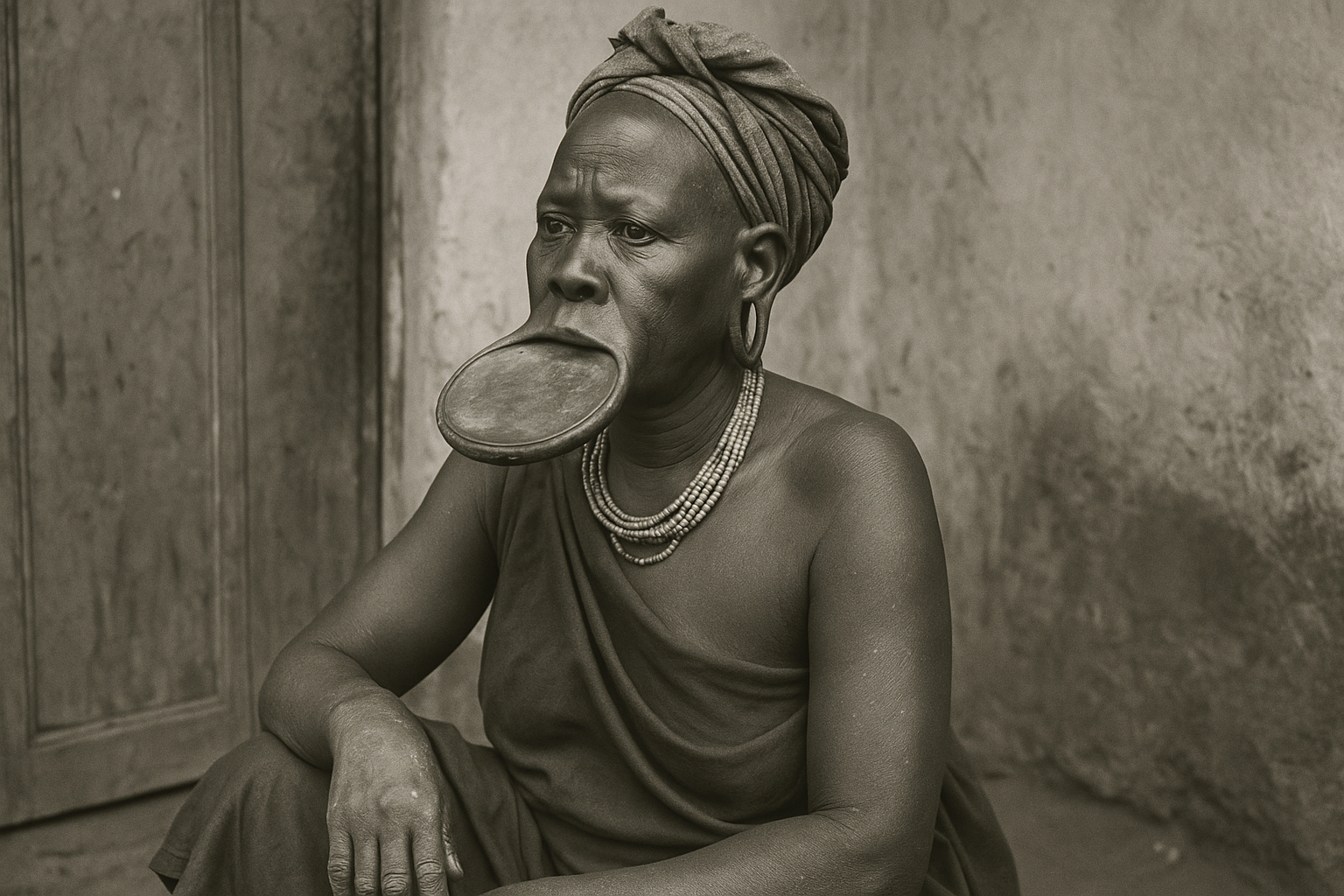The Curse of the Ubangis, American Circus Exploitation, and the Shadow of Superstition
When readers picked up the November 15, 1951 issue of Jet Magazine, they held far more than a pocket-sized digest of news and culture. They were confronted with a headline that both shocked and fascinated: “The Curse of the Ubangis.” The article explored the superstition, spectacle, and cultural misunderstandings surrounding African women who had been brought to the United States as performers decades earlier. In an era when race, science, and entertainment collided in often disturbing ways, Jet’s decision to highlight this story revealed much about mid-century America and the role of the Black press in reshaping conversations about identity and exploitation.
For Jet’s readers, this was more than a curiosity piece. It was a mirror of how African heritage was treated in Western popular culture and a reminder of why the magazine existed: to reclaim dignity, tell the truth, and give Black Americans a voice in stories that mainstream media either sensationalized or ignored.
The early 1950s were a complex and turbulent time for Black Americans. Segregation was still the law of the land, Jim Crow reigned across the South, and the civil rights movement had not yet exploded into mass protest. Yet, at the same time, the seeds of change were being sown: court battles were being waged, community leaders were organizing, and the Black press was documenting every moment.
The Ubangi women had first come to American attention decades earlier, in the 1930s, when circus promoters billed them as exotic spectacles. Their lip plates — an African cultural practice — were displayed in sideshows, where white audiences consumed them as oddities. By 1951, the women’s story had taken on a strange afterlife, with rumors of curses and misfortunes following those who exploited them.
For Jet readers in 1951, this was not just entertainment gossip. It was a chance to reflect on how African identity had been misrepresented, commodified, and mocked in Western culture. At a time when Black Americans were fighting for recognition as full citizens, the “Ubangi curse” story became a parable about dignity, exploitation, and survival.
By the early 1950s, Jet Magazine had already established itself as one of the most vital voices in African American media. Unlike mainstream publications that often sensationalized stories of race, Jet gave them depth, context, and cultural meaning.
The November 15, 1951 issue placed the Ubangi story alongside articles on politics, civil rights, and Black entertainment. Jet’s editors knew their audience wanted both truth and connection — stories that reflected the struggles of their community but also the larger history of Black people across the world.
For many African American families, Jet was a lifeline. It brought stories that white-owned newspapers ignored or distorted. In the case of the Ubangis, Jet offered not just titillation, but a conversation about heritage, stereotypes, and the ongoing legacy of racial exploitation.
The cover of Jet Magazine in 1951 stood out boldly on newsstands. Jet’s pocket-sized format, its sharp photography, and its bright headlines made it instantly recognizable. The Ubangi headline, striking and sensational, grabbed readers’ attention — but Jet’s treatment inside the pages went further than a sideshow gimmick.
The article used a mix of narrative reporting and cultural commentary to reflect on the phenomenon of the “Ubangi curse.” It asked why stories of misfortune followed those who exploited African culture, and it implicitly challenged readers to see the women not as curiosities, but as human beings with histories and dignity.
This was Jet’s unique power: combining reporting with cultural analysis. Where mainstream outlets reduced the Ubangis to spectacles, Jet made their story a cultural case study — a way to talk about Black identity, colonial legacies, and the tension between superstition and respect.
-
The Legacy of Exploitation – The article reminded readers that the Ubangi women had been treated as oddities in American circuses, a symbol of how African traditions were misunderstood and commodified.
-
The Rumor of a Curse – Jet documented claims that misfortunes had befallen those who profited from the women’s exhibition, adding a layer of intrigue and superstition.
-
Cultural Clash – At its heart, the article showed the stark divide between African customs and American perceptions, raising questions about respect, misunderstanding, and ridicule.
-
A Mirror for Black America – For Jet’s audience, the Ubangi story was not just about faraway women — it was about how Black people everywhere were judged, displayed, and dehumanized in a society that resisted seeing them as equals.
Each of these highlights made the article resonate more deeply than its sensational headline might suggest. Jet used the Ubangi story as a window into larger truths about race, culture, and representation.
For collectors, the November 15, 1951 issue of Jet Magazine is a rare and significant find.
Why is it so collectible?
-
Historical Timing – Coming just before the great civil rights battles of the 1950s and 1960s, this issue captures a cultural moment when Black identity was being debated in both popular culture and politics.
-
Unique Story – The “Ubangi curse” feature stands out as one of Jet’s most unusual and provocative articles, blending folklore, cultural commentary, and history.
-
Cultural Artifact – This magazine is not just a piece of journalism. It is a preserved document of how African American media wrestled with questions of heritage, exploitation, and dignity.
-
Collector Demand – Vintage Jet magazines from the early 1950s are increasingly sought after by historians, collectors, and families preserving their cultural roots.
Holding this issue is holding an original artifact of mid-20th-century African American history — a reminder of how stories were told, debated, and remembered.
Jet’s coverage of “The Curse of the Ubangis” endures because it captured more than superstition. It captured the cultural anxieties of a community in transition — one moving from enforced invisibility to growing power.
While mainstream America often treated Black culture as exotic spectacle, Jet showed its readers the deeper story. It refused to let African heritage be reduced to sideshow entertainment, instead offering analysis, dignity, and historical weight.
Today, reading this issue helps us understand the long struggle over representation. It reminds us that the fight for respect was not only in the courtroom or the voting booth, but also in how stories were told and remembered.
If this issue of Jet Magazine sparks your interest, you’ll want to explore more.
👉 Browse the full collection of original Jet magazines here: Original Jet Magazines Collection
Inside the collection, you’ll discover:
-
Civil rights milestones, from the Montgomery Bus Boycott to the March on Washington.
-
Profiles of iconic figures like Martin Luther King Jr., Jackie Robinson, and Josephine Baker.
-
Unflinching coverage of tragedies like the murder of Emmett Till.
-
Stories of everyday Black life, from church gatherings to college graduations.
Each issue is a time capsule — a tangible link to the struggles, joys, and dreams of past generations.
The November 15, 1951 issue of Jet Magazine, with its provocative feature on “The Curse of the Ubangis,” remains one of the most unusual and compelling cultural documents of its time. It wasn’t only about superstition. It was about how African identity was represented, how Black dignity was defended, and how a community reclaimed the right to tell its own stories.
Today, this issue is not only historically significant but also highly collectible. It stands as both a cultural mirror of 1951 and a lasting artifact of African American history.
For anyone who values history, vintage Jet magazines are more than reading material — they are living artifacts. And through them, the past speaks directly to us.

